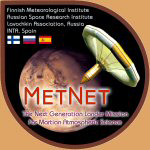
Mars MetNet Precursor Mission Science Objectives
Since meteorological and climatological phenomena have both temporal and spatial variations, characterisation of such phenomena require ideally simultaneous observations at multiple locations and over a sufficiently long period of time. Hence a surface network is the preferred means of observation. The spatial coverage as well as the temporal duration and resolution of observations need to be commensurate with the characteristic spatial and temporal scales of the phenomena being observed. The MetNet Mars Precursor Mission comprises, however, a single lander (or at most two landers) and can therefore address on its own only a subset of the objectives of a network. The key contribution of the MetNet Mars Precursor Mission is hence
- Availability of new and high-quality & resolution atmospheric vertical structure as well as long-duration (of the order of a Martian year) in situ meteorological and imaging observations at a single or few landing site(s)
A longer-term benefit of a successful MetNet Mars Precursor Mission and the accompanying proof-of-concept is the
- Demonstrated feasibility of the lander concept for a meteorological network mission.
This would consederably enhance the possibilities of finally implementing a globally dispersed in situ network. The goals and objectives of the MetNet Mars Precursor Mission are outlined in greater detail in the subsections below.
General circulation and climatological cycles
Mesoscale phenomena
Planetary boundary layer and surface-atmosphere interactions
Atmospheric vertical structure
How to Join the MetNet Science Team?
At present, access to the MetNet mission planning information and later to the collected data are reserved for members of the MetNet Core Team and the MetNet Science Team... Read more



